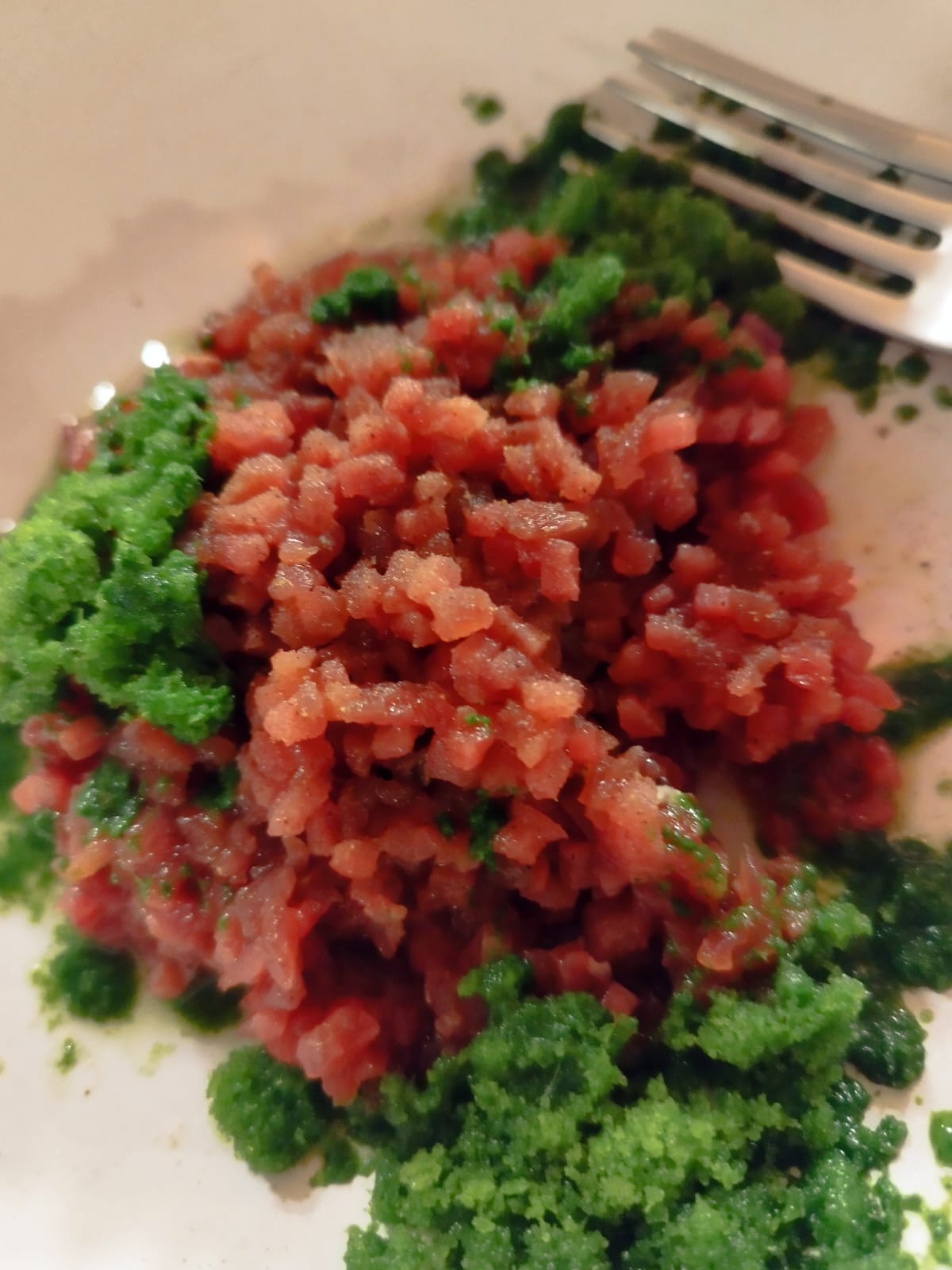Borgo Santa Cecilia e Officina dei Sapori” , Gubbio
Questa volta è stato il Gambero Rosso a guidarci nella scelta dei ristoranti durante la nostra visita a Gubbio. Borgo Santa Cecilia si trova nel cuore della campagna, a 25 km dal nostro albergo (Casa Minotti, che è semplicemente meraviglioso). Durante il viaggio di ritorno, ci siamo chiesti se valesse davvero la pena percorrere 50 km solo per cenare lì. La conclusione? Non c’è un posto al mondo che, per noi, giustifichi un tale impegno. Tuttavia, Santa Cecilia è un borgo incantevole nella campagna eugubina, noto per la produzione propria dei prodotti serviti a tavola. Vale sicuramente la pena di visitarlo, se non altro per la qualità della norcineria offerta. Abbiamo gustato un piatto misto di maiale e cinghiale, in cui ogni pezzo superava l’altro in raffinatezza. Un sapiente uso del sale, una magia nelle spezie, e una materia prima di altissimo livello. Persino l’ammazzafegato era di una raffinatezza sorprendente. Mi pento di non aver fatto scorta dopo cena. Tra gli antipasti, un’altra delizia: una ceviche di cinghiale. Lombo di cinghiale tagliato a coltello e brevemente marinato. Un piatto fresco come una ceviche, ma di cinghiale. Persino gli italiani dovrebbero superare la loro avversione per la carne cruda di “sus scrofa”.
Degno di nota anche il primo piatto: “tortelli di cacciagione, tabacco e stracchino di capra”. Eravamo ancora così incantati dagli antipasti che non siamo riusciti a valutare pienamente i tortelli.
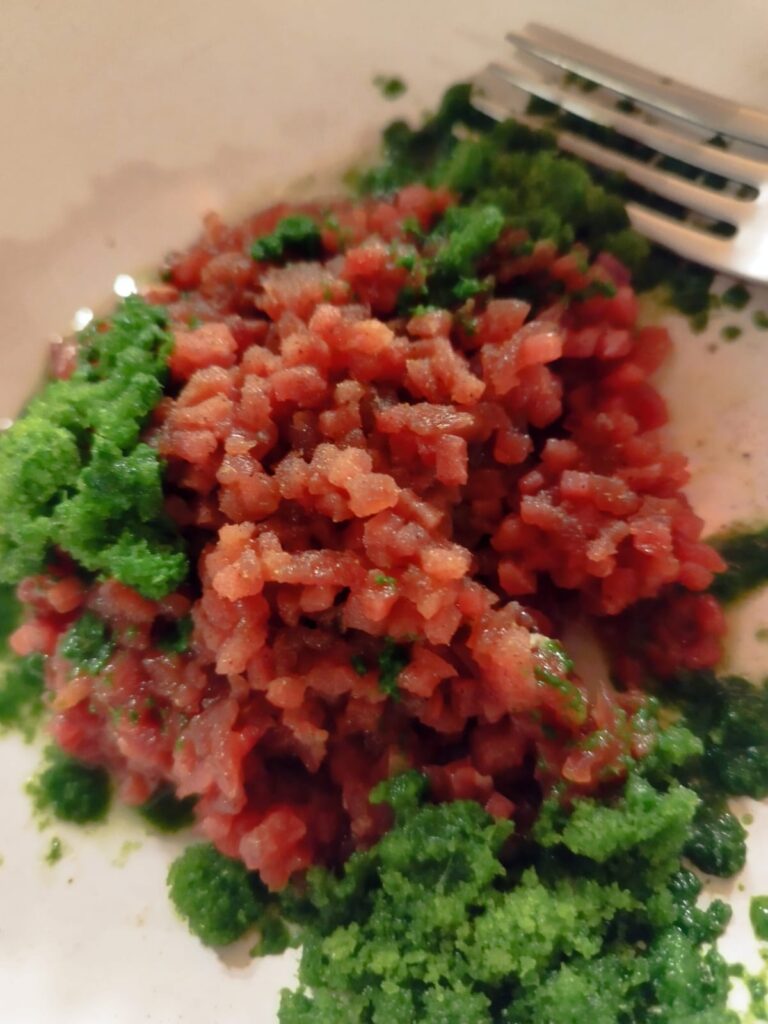
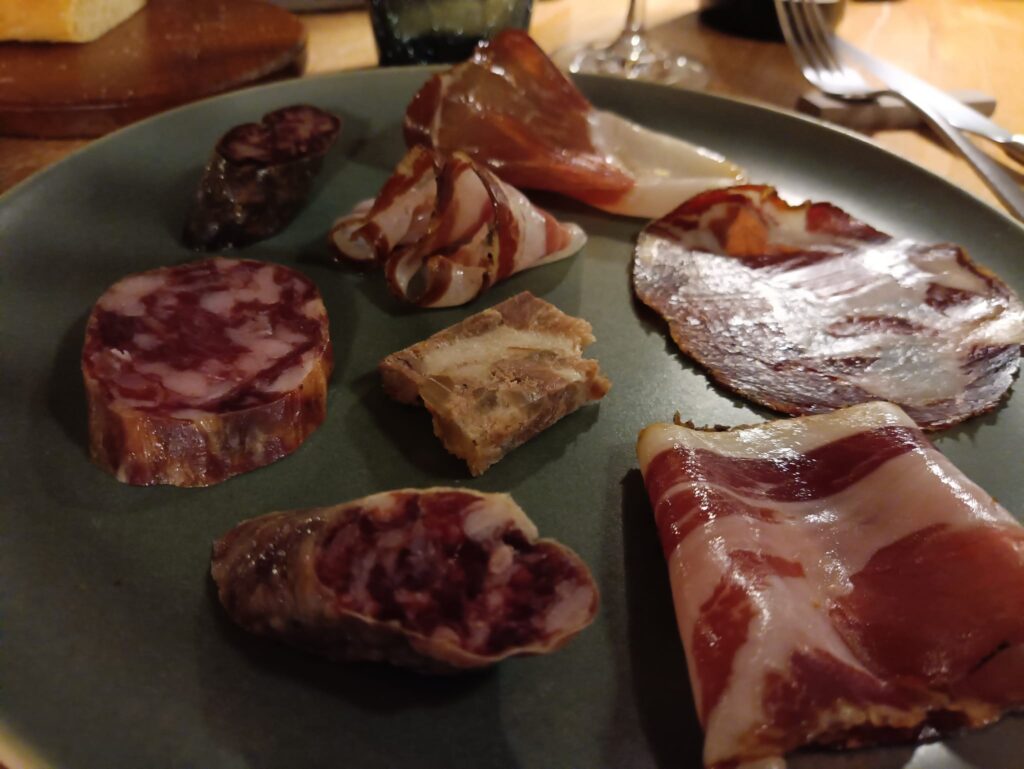
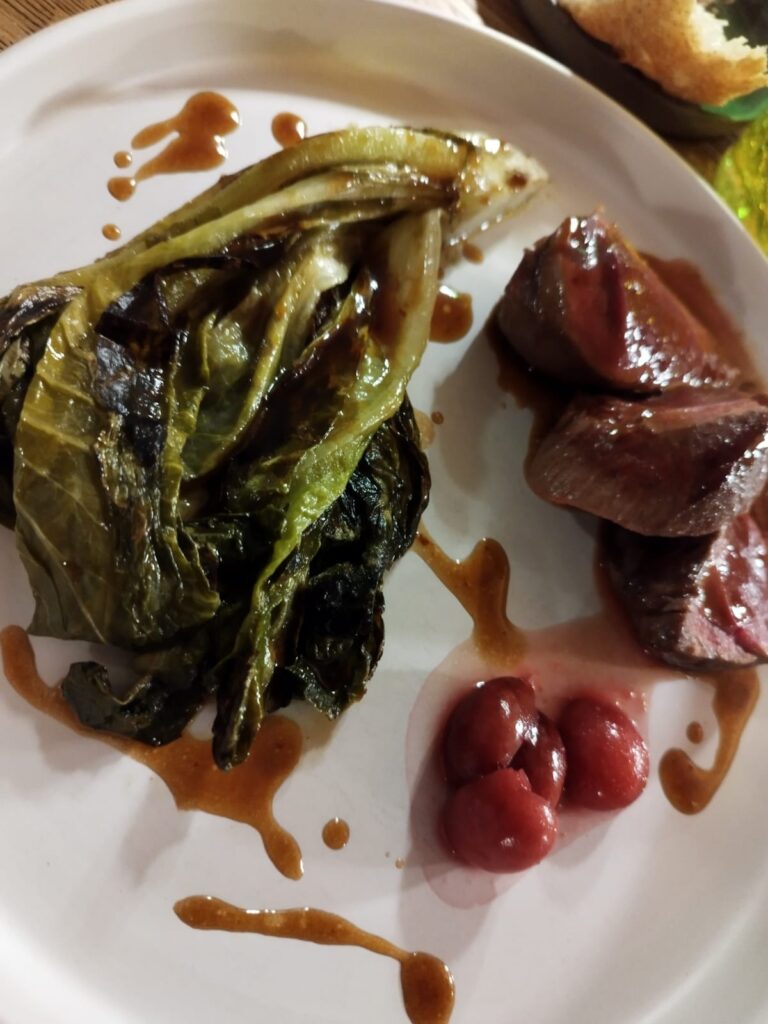
Per i secondi, abbiamo scelto una bistecca di maiale e il capriolo. Il capriolo era perfetto, quasi crudo, lasciando spazio per apprezzare al meglio la qualità della carne. La bistecca di maiale, invece, non ci ha convinto; il fondo era troppo salato, cosa che ho segnalato al maître. Dopo i secondi, non c’era più spazio per il dolce, il che la dice lunga sulle porzioni. Due antipasti, un primo, e due secondi sono stati sufficienti per saziare entrambi. Da non dimenticare il saluto iniziale dalla cucina: una spuma di fragola e pomodoro e una crème brûlée di peperoni.
Per quanto riguarda il vino, ci siamo affidati al maître, che ci ha consigliato un “Monica” davvero apprezzabile (30 €). Il conto totale è stato di 160 €, non poco, ma in linea con la quantità e la qualità del cibo. Tuttavia, si devono percorrere 25 km da Gubbio per arrivarci.
La sera successiva siamo stati al centro di Gubbio, all’“Officina dei Sapori”. Dopo aver trascorso l’intera giornata a Gubbio, ci siamo resi conto che il locale scelto era più caro di tutti gli altri che avevamo visto, il che ci faceva ben sperare.
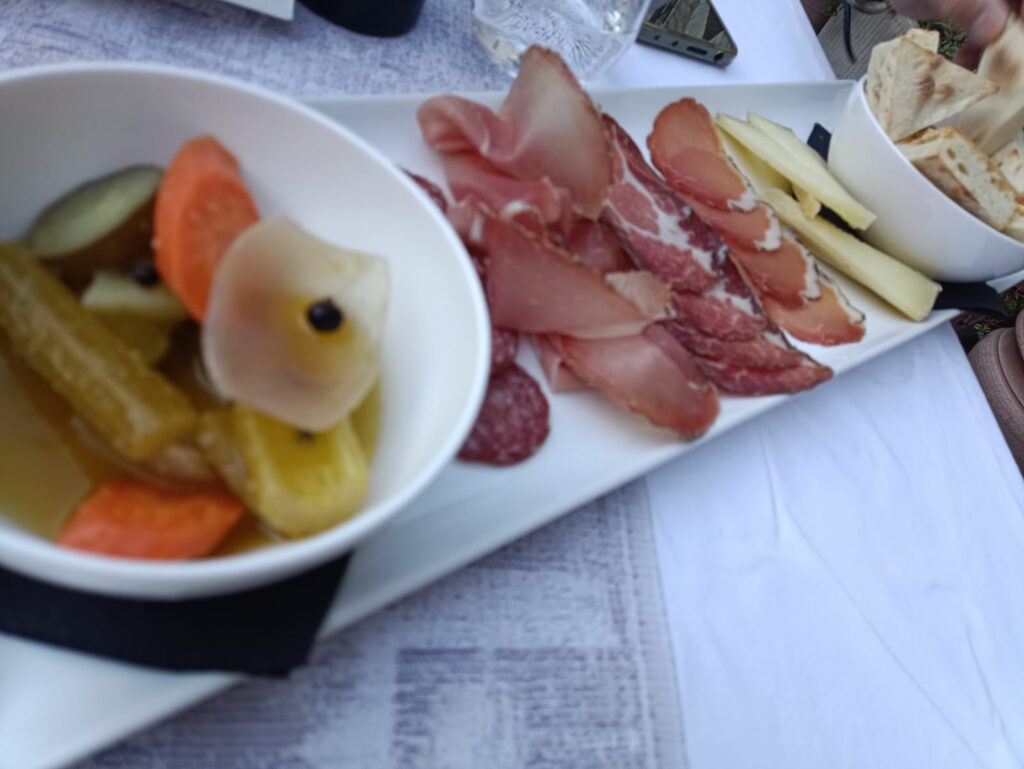
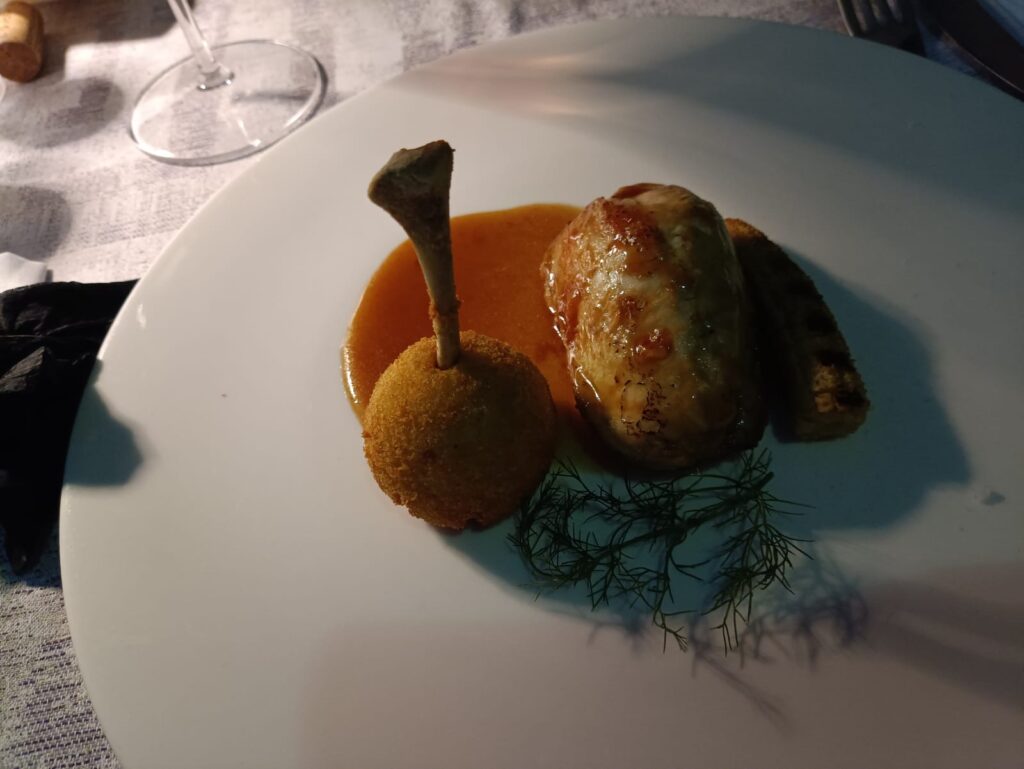
Abbiamo ordinato nuovamente la norcineria: nulla di cui lamentarsi, ma niente a che vedere con quella di Santa Cecilia. Tuttavia, con la norcineria è arrivato l’unico piatto d’eccellenza di tutta la cena: verdure leggermente fermentate. Amiamo le verdure marinate, ma detestiamo l’acidità dei sottaceti. Queste verdure erano perfette. Servite con torta al testo calda e un buon olio, hanno salvato l’intera cena. Il primo era un risotto con rapa e anguilla affumicata: l’anguilla era buona, ma il risotto risultava troppo salato. I due secondi avevano nomi altisonanti, come “Galletto alla ghiotta” e “Terrina di maiale”, ma mancavano di quel “tocco” di sapore, specialmente i “lollipop di fegatini”. La terrina era un “pulled pork” pressato in un quadrato, ma anch’esso troppo salato. Il dessert lo abbiamo già dimenticato. Tuttavia, la “Bocca di Rosa” di Tabarrini ha contribuito a rendere la cena comunque piacevole.
In futuro, seguirò ancora di più il mio istinto piuttosto che le guide.
—
English Version
This time, it was the Gambero Rosso that guided us in choosing the restaurants during our visit to Gubbio. Borgo Santa Cecilia is located in the heart of the countryside, 25 km from our hotel (Casa Minotti, which is simply wonderful). On the drive back, we wondered if it was really worth traveling 50 km just to dine there. The conclusion? There isn’t a place in the world that, for us, justifies such an effort. However, Santa Cecilia is a charming village in the Eugubina countryside, known for its own production of the food served at the table. It is definitely worth a visit, if only for the quality of the cured meats offered. We enjoyed a mixed plate of pork and wild boar, where each piece surpassed the other in refinement. A wise use of salt, a magical touch with spices, and top-quality ingredients. Even the ammazzafegato was surprisingly refined. I regret not stocking up after dinner. Among the appetizers, another delight stood out: a wild boar ceviche. Wild boar loin cut by hand and briefly marinated. A dish as fresh as a ceviche, but made with wild boar. Even Italians should overcome their aversion to raw meat from the species “sus scrofa.”
The first course was also noteworthy: “tortelli with game, tobacco, and goat stracchino.” We were still so enchanted by the appetizers that we couldn’t fully appreciate the tortelli.
For the main courses, we chose a pork steak and venison. The venison was perfect, almost raw, allowing the quality of the meat to shine. The pork steak, however, didn’t win us over; the sauce was too salty, which I mentioned to the maître. After the main courses, there was no room left for dessert, which says a lot about the portion sizes. Two appetizers, one first course, and two main courses were enough to satisfy both of us. Not to be forgotten was the amuse-bouche at the beginning: a strawberry and tomato foam and a pepper crème brûlée.
As for the wine, we followed the maître’s advice and were served a very appreciable “Monica” (30 €). The total bill was 160 €, which isn’t cheap but is in line with the quantity and quality of the food. However, you have to travel 25 km from Gubbio to get there.
The following evening, we dined in the center of Gubbio at “Officina dei Sapori.” After spending the entire day in Gubbio, we realized that the chosen restaurant was more expensive than all the others we had seen, which gave us hope.
We ordered the cured meats again: nothing to complain about, but nothing compared to those at Santa Cecilia. However, with the cured meats came the only excellent dish of the entire dinner: lightly fermented vegetables. We love marinated vegetables but dislike the acidity of pickles. These vegetables were perfect. Served with warm torta al testo and good olive oil, they saved the entire dinner. The first course was a risotto with turnip and smoked eel: the eel was good, but the risotto was too salty. The two main courses had grandiose names, like “Galletto alla ghiotta” and “Terrine of pork,” but they lacked that “kick” of flavor, especially the “lollipops of liver.” The terrine was a “pulled pork” pressed into a square, but also too salty. We’ve already forgotten the dessert. However, the “Bocca di Rosa” by Tabarrini helped make the dinner enjoyable nonetheless.
In the future, I will rely even more on my instincts rather than on guides.

